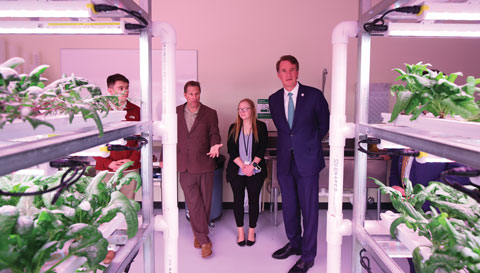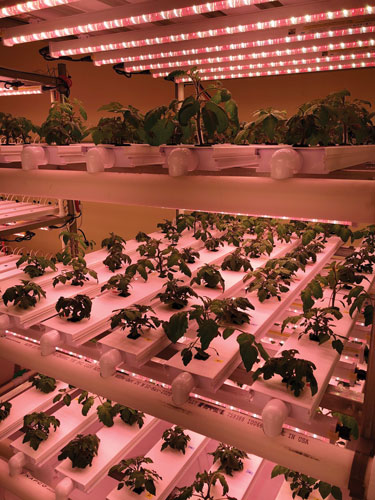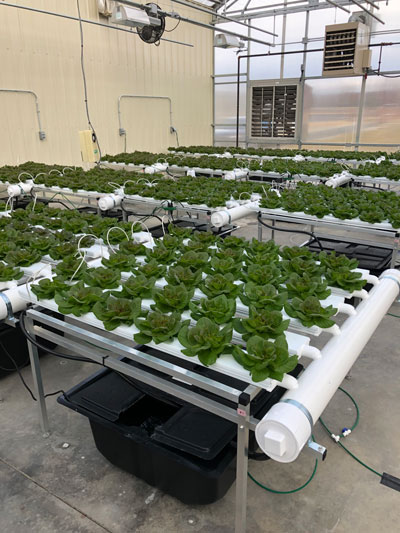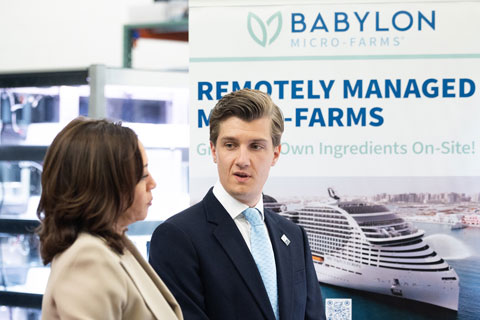8/1/2023
Research, Workforce & Policy
Jennifer Polanz

First, it was the March proclamation by Governor Glenn Youngkin’s office declaring the month “Virginia Controlled Environment Agriculture Month.” Then, it was a policy announcement in May celebrating the passage of legislation to expand agricultural sale tax exemptions to include equipment and products used in CEA facilities.
Pictured: Gov. Glenn Youngkin (right) receives a tour of the Virginia Tech-Institute for Advanced Learning and Research (IALR) Controlled Environment Agriculture Innovation Center located on IALR’s campus in Danville, Virginia. Photo courtesy of the Institute for Advanced Learning and Research.
These were the two activities that piqued my interest and turned my attention toward the Commonwealth, known for their tagline “Virginia is for Lovers.” Today, that could be amended to “Virginia is for Lovers of CEA,” thanks to a laser-like focus on the industry and investments that could reap benefits for the state and CEA far into the future. But I’m getting ahead of myself … let’s back up a bit ...
Defining the pillars
Early on in Youngkin’s tenure, he sat down with Agriculture Secretary Matthew Lohr, who’s no stranger to agriculture himself, as he grew up on a farm that he continues to run today.
“When we took office a year and a half ago, we already had some nice companies coming to Virginia or in Virginia. One of the first meetings I had with the governor … we were talking about agriculture. It’s our No. 1 industry,” Secretary Lohr said via a Zoom chat in early June. “He’s a futuristic visionary and he loves technology, and we were talking about indoor farming and he was fascinated by it.
“And so the more we talked about it he said, ‘You know, I think this is something that could be our legacy with ag and forestry, to be No. 1.’ That’s the way the governor works. He’s like, we just have to be the best.”
They identified three key areas to focus on—some already in progress, but requiring more funding. Those three pillars, as you may have guessed, are research, workforce and policy. Let’s break each of those down with their potential impacts.

Research collaborations
This pillar was already happening long before Youngkin’s term in office, but this is an area that may be getting more funding to keep the work going. One example here is the Institute for Advanced Learning and Research (IALR) in Danville, which is a unique—and sometimes confusing—collaboration between government, university and business.
Pictured: Here you can see evaluation of dwarf tomatoes cultivars for use in vertical farming using vertical rack systems at the CEA Innovation Center in Danville. Photo: Michael Evans.
Here’s the rundown, according to Dr. Scott Lowman, vice president of applied research at the institute: it receives funding from the state (but isn’t a state agency), works with Virginia Tech and hosts research from Virginia Tech researchers due to its state-of-the-art facilities (but isn’t technically a part of Virginia Tech), and collaborates with private businesses to forward research on a couple of different fronts, with CEA just being one of them, albeit a big one (others include robotics, data analytics, imaging and the development of biologicals). The institute also has a 500-person capacity conference center, which you may have experienced last year if you attended the CEA Summit East in Danville.
“The main thing is we’re not just scientists down here coming up with projects we believe are important. We are actually responding to the industry challenges,” Scott said, noting they have research partnerships with CEA growers and agtech companies that are protected by non-disclosure agreements (NDAs). “We are directly trying to answer industry questions. We try to do what they need.”
Fulfilling those needs includes services like water quality testing, seed monitoring, and testing and validating growing strategies at their facility for growers. They’re also working with companies outside the industry to see if their technology is applicable for CEA operations. More funding is expected to come to IALR, too, through the state budget process, which is increasing the amount dedicated to CEA research that will flow through IALR.
 Virginia Tech’s role is intertwined with IALR, with both spanning the two pillars of research and workforce as part of their goals. Dr. Michael Evans is the co-director of the CEA Innovation Center with Scott that’s housed at IALR where this research takes place. He’s also the director and a professor of controlled environment agriculture in the School of Plant and Environmental Sciences at Virginia Tech, and many of the undergrad and graduate students who are in the CEA program there work at the CEA labs at IALR.
Virginia Tech’s role is intertwined with IALR, with both spanning the two pillars of research and workforce as part of their goals. Dr. Michael Evans is the co-director of the CEA Innovation Center with Scott that’s housed at IALR where this research takes place. He’s also the director and a professor of controlled environment agriculture in the School of Plant and Environmental Sciences at Virginia Tech, and many of the undergrad and graduate students who are in the CEA program there work at the CEA labs at IALR.
Pictured: Greenhouse-based lettuce research at the CEA Innovation Center in Danville, using nutrient film technique (NFT) systems. Photo: Michael Evans.
“I think the partnership between Virginia Tech, IALR, the state and economic development—all these entities within the state working together, hand-in-hand, has allowed us to have quite a measure of success,” Michael noted. “We’ve told everybody who’s located here and looking to come here—everybody’s got different needs—we love to work together and do what we have in our capabilities to help companies be the best they can be.”
Workforce development
The second leg of the stool is workforce development, which is critical in an age where labor is difficult, to say the least. Secretary Lohr noted programs that start as early as middle school with a program called GoTec, where schools have mini indoor vertical growing operations set up to create awareness. But the main work is being done at the college level with a full bachelor’s degree of science being developed at Virginia Tech, and an associate’s degree in CEA and ag technology being developed at Southwestern Community College in Roanoke.
“The goal is if we can get this curriculum down pat, and they’re working with a lot of our companies and IALR, then we can replicate it at community colleges across the state,” he added.
At Virginia Tech, Michael said they recognize not everyone would need a degree, so they’re working on something akin to a certificate program or modules, where employees who are currently working, but want or need to develop additional skillsets, can learn more. Currently, he’s in the process of engaging companies to make sure anything they offer meets industry needs.
Policy & incentives
The final pillar, or leg of the stool, involves legislation and incentives. These are the drivers that entice vertical farm companies like Plenty, AeroFarms and greenhouse tomato producer Red Sun Farms to Virginia. There are a couple of examples of this, including the Agriculture and Forestry Industry Development Fund (AFID).
“It’s an economic incentive tool for ag companies that are locating here or expanding,” Secretary Lohr explained. “It’s 10 years old and one of the first applicants-recipients was Red Sun Farms. That was the first time Virginia started dabbling in incentivizing these types of companies.”
In the past, that fund has had about $1.25 million to disburse to agriculture companies. As of press time, the new state budget hadn’t been finalized, but it had an increase of an additional $1.5 million earmarked in it just for CEA operations.
Another incentive passed in May is the aforementioned sales tax exemption for CEA growers, which he said is patterned after data centers.
“We got that passed, so when a company like Plenty comes in, all the indoor equipment that’s used to grow will now be exempt from sales and use tax,” he said. “That’s a huge incentive for companies that are expanding and for companies that are looking to come here.”
When Gov. Youngkin signed the legislation in May, he spoke about the importance of CEA for the state and why he’s gone after it.
“I think this is a chance for us to take the early wins that we got as a state and fundamentally double down,” he said. “Hit the accelerator and let’s go ahead and put this competition behind us and make Virginia the No. 1 state for controlled environment agriculture—not just in the nation, but in the world.”
Is it working?
It’s premature to say, but there are definitely vertical farms and growers expanding into Virginia, most notably AeroFarms, which opened their Danville microgreens operation in September 2022, and Plenty, which is building a 120-acre campus in Richmond and expects to be shipping strawberries grown there by the end of the year.
I talked with AeroFarms Chief Marketing Officer Marc Oshima, who said the partnerships for research and workforce development through IALR and Virginia Tech were a big part of their decision, along with Virginia’s ideal geographic location that allows them to reach a population of more than 50 million within a day’s drive. The incentives help, too, as part of the overall package.
“For us, when we think about the future, we have to think about the whole ecosystem because it’s about building an industry,” he said, adding there’s still more research to be done specifically on vertical farming. “So this allows us to have the opportunity to influence course work and what’s needed in the skill set and collaborate, even on R&D, but the idea is that we’re creating future team members, as well.
“I think that’s been important for us because, again, we’re creating an industry. So how can we help bring everybody along and help us amplify our work?”
Marc noted, too, that they’ve received support from both sides of the aisle, first in Newark, New Jersey, where the AeroFarms headquarters are, and now in Danville, Virginia. When they began looking at Virginia, Gov. Ralph Northam, a Democrat, was in office, and he was equally as supportive as Youngkin, a Republican, has been.
“What does it mean? It’s obviously about job creation. Some of the incentives we’ve received are around creating 92 jobs—we’ve exceeded that, we’re well into the 130s with a higher target,” Marc said. “We’ve really been aligned in terms of that. We’ve worked closely with the different facilities, whether it’s IALR or Virginia Tech or other community things for the recruitment side.”
He added that the site AeroFarms is on in Danville used to be a family run farm for generations by the Willis family.
“We’ve hosted Mr. Willis and he’s just amazed that it’s now been returned to farmland, but a new way of farming,” he said. “I think that’s what Virginia is embracing over all is, ‘What is the future of farming?’ and ‘What does the future of the farmer look like?’ and new means of production can help support that.”

A Visit From the VP
In an example of bipartisan interest in CEA in Virginia, back in May, U.S. Vice President Kamala Harris visited Babylon Micro-Farms in Richmond, Virginia, a company that manufacturers stand-alone vertical farming systems. I reached out to Founder and CEO Alexander Olesen to find out more about the event.
Pictured: Alexander Olesen, right, explains the business to Vice President Kamala Harris.
He said the visit happened on Thursday, May 4 as a celebration and recognition of Small Business Week and the administration’s support of businesses through the State Small Business Credit Initiative (SSBCI). Babylon received a $150,000 equity investment from the Virginia Innovation Partnership Corporation supported by the state’s SSBCI program (yet another incentive program). Alexander noted that his company ticked all the boxes of what the administration was looking for in a host for the event, which was a small local manufacturer and a clean, sustainable technology company.
“It was a bit of a whirlwind,” Alexander added. “I got a call on Sunday morning and I was like, ‘Sure, she can come visit.’ I don’t think anyone quite knew what that meant.”
It meant a visit early on from the Secret Service team to check out the location, run checks on employees, and then an advance team to set up the stage and factory tour.
The visit was great for the company to be able to expand its reach and get its message out with the exposure of an official VP visit. He said it was validating to be recognized for taking a niche application of vertical farming and attempting to make it more mainstream.
“It demonstrated that we’re our own lane in this market and this lane has a lot of potential,” he added.